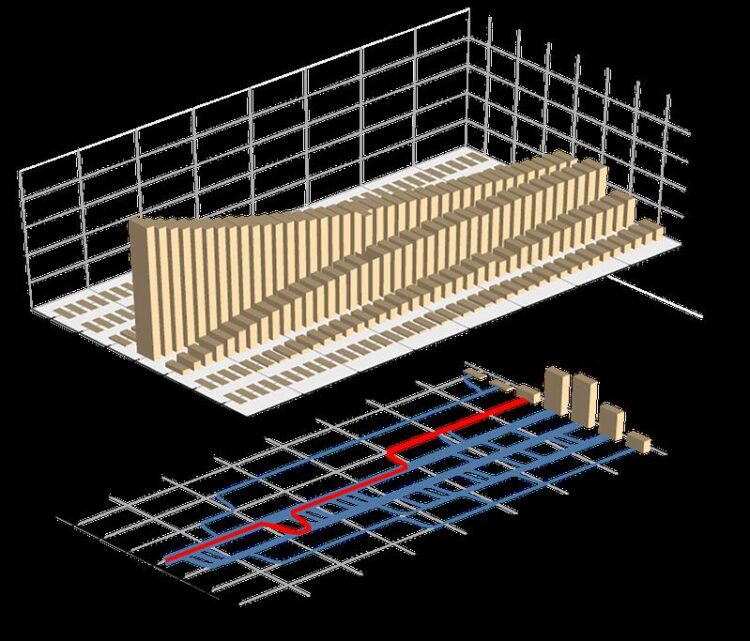A benchmark for single-electron circuits

Oben: Zählstatistik (ptx) eines Fehlersignals (x) das von einem Einzelladungsdetektor erfasst wurde, dargestellt in Abhängigkeit der Anzahl an Wiederholungen (t) der Transferoperation, die von Einzelelektronenschaltung ausgeführt wurden.
Unten: Simulation des diesem Messsignal zugrunde liegenden Random-Walks (blaue Linien). Die Linienbreite zeigt dabei die Häufigkeit an, mit der ein Schritt auftritt. Die rote Linie verdeutlicht beispielhaft einen einzelnen Pfad des Fehlersignals. PTB
A new methodology for an abstract and universal description of the fidelity of quantum circuits (Joint Press Release with the University of Latvia)
Manipulating individual electrons with the goal of employing quantum effects offers new possibilities and greater precision in electronics. However, these single-electron circuits are governed by the laws of quantum mechanics, meaning that deviations from error-free operation still occur – albeit (in the best possible scenario) only very rarely. Thus, insights into both the physical origin the and metrological aspects of this fundamental uncertainty are crucial for the further development of quantum circuitry. To this end, scientists from PTB and the University of Latvia have collaborated to develop a statistical testing methodology. Their results have been published in the journal Nature Communications.
Single-electron circuits are already used as electric-current quantum standards and in quantum-computer prototypes. In these miniaturized quantum circuits, interactions and noise impede the investigation of the fundamental uncertainties and measuring them is a challenge, even for the metrological precision of the measurement apparatus.
In the field of quantum computers, a testing procedure also referred to as a “benchmark” is frequently used in which the operating principle and fidelity of the entire circuit are evaluated via the accumulation of errors following a sequence of operations. Based on this principle, researchers from PTB and the University of Latvia have now developed a benchmark for single-electron circuits. Here, the circuit’s fidelity is described by the random steps of an error signal recorded by an integrated sensor while the circuit repeatedly executes an operation. The statistical analysis of this “random walk” can be used to identify the rare but unavoidable errors when individual quantum particles are manipulated.
By means of this “random-walk benchmark”, the transfer of individual electrons was investigated in a circuit consisting of single-electron pumps developed at PTB as primary standards for realizing the ampere, an SI base unit. In this experiment, sensitive detectors record the error signal with single-electron resolution. The statistical analysis made possible by counting individual particles not only shows fundamental limitations of the circuit’s fidelity induced by external noise and temporal correlations but also provides a robust measure of assessing errors in applied quantum metrology.
The methodology developed within the scope of this work provides a rigorous mathematical foundation for validating quantum standards of electrical quantities and opens new paths for the development of integrated complex quantum systems.
(es/ptb)
Picture:
Top: Counting statistics (ptx) of an error signal (x) recorded by a single-charge detector, shown as a function of the number of repetitions (t) of the transfer operation; these repetitions were performed by the single-electron circuit.
Bottom: Simulation of the underlying “random walks” (blue lines) based on this measurement signal. Here, the width of the line shows how frequently a step takes place. The red line exemplifies a single path of the error signal.
Wissenschaftliche Ansprechpartner:
Dr. Niels Ubbelohde, Working Group 2.53, Low-dimensional electron systems,
Phone: +49 531 592-2534, e-mail: niels.ubbelohde@ptb.de
Originalpublikation:
D. Reifert, M. Kokainis, A. Ambainis et al.: A random-walk benchmark for single-electron circuits. Nat Commun 12, 285 (2021), https://doi.org/10.1038/s41467-020-20554-w
Media Contact
All latest news from the category: Physics and Astronomy
This area deals with the fundamental laws and building blocks of nature and how they interact, the properties and the behavior of matter, and research into space and time and their structures.
innovations-report provides in-depth reports and articles on subjects such as astrophysics, laser technologies, nuclear, quantum, particle and solid-state physics, nanotechnologies, planetary research and findings (Mars, Venus) and developments related to the Hubble Telescope.
Newest articles

A universal framework for spatial biology
SpatialData is a freely accessible tool to unify and integrate data from different omics technologies accounting for spatial information, which can provide holistic insights into health and disease. Biological processes…

How complex biological processes arise
A $20 million grant from the U.S. National Science Foundation (NSF) will support the establishment and operation of the National Synthesis Center for Emergence in the Molecular and Cellular Sciences (NCEMS) at…

Airborne single-photon lidar system achieves high-resolution 3D imaging
Compact, low-power system opens doors for photon-efficient drone and satellite-based environmental monitoring and mapping. Researchers have developed a compact and lightweight single-photon airborne lidar system that can acquire high-resolution 3D…





















